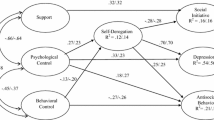Abstract
In order to investigate the relationship between aspects of child rearing and adolescent self-concept, 130 males and females in grades 7, 8, and 9 completed Schaefer's Children's Report of Parental BehaviorInventory (CRPBI) and Coopersmith's Self-Esteem Inventory. Correlations between the Acceptance/Rejection dimension of the CRPBI and the various self-esteem subscores were positive. Correlations between the self-esteem scores and the Psychological Autonomy/Psychological Control dimension of the CRPBI were negative. The correlations were stronger for perceptions of mothers' as opposed to fathers' child-rearing practices. Analyses of variance indicated that ninth-graders perceived their parents as less accepting than seventhor eighth-graders. High self-esteem adolescents perceived their parents as more accepting, as using less psychological control, and as not being overly firm in making and enforcing rules and regulating the adolescents' behavior. The results support the contention that optimal self-concept development takes place in an atmosphere of acceptance that allows the adolescent autonomy and the opportunity to learn competencies.
Similar content being viewed by others
References
Adams, G., and Jones, R. (1983). Female adolescents' identity development: Age comparisons and perceived child-rearing experience.Dev. Psychol. 19: 249–256.
Armentrout, J., and Burger, G. (1972). children's reports of parental child-rearing behavior at five grade levels.Dev. Psychol. 7: 44–48.
Baumrind, D. (1968). Authoritarian vs. authoritative parental control.Adolescence. 3: 255–272.
Becker, W. (1964). Consequences of different kinds of parental discipline. In Hoffman, M., and Hoffman, L. (eds.),Review of Child Development Research, Vol. 1, Russell Sage, New York.
Burger, G., and Armentrout, J. (1971). Comparative study of methods to estimate factor scores for reports of parental behavior.Proc. 79th Ann. Convent. Am. Psychol. Assoc. 6: 149–150.
Coopersmith, S. (1967).The Antecedents of Self-Esteem, Freeman, San Francisco.
Coopersmith, S. (1974). Norms for the Coopersmith Self-Esteem Inventory. Unpublished manuscript.
Cross, H. (1969). College students' memories of their parents: A factor analysis of the CRPBI.J. Consult. Clin. Psychol. 33: 275–278.
Douvan, E., and Adelson, J. (1966).The Adolescent Experience, Wiley, New York.
Dusek, J. (1977).Adolescent Development and Behavior, St. Martin's Press, New York.
Elder, G. (1962). Structural variations in the child-rearing relationship.Sociometry 25: 241–262.
Elder, G. (1963). Parental power legitimation and its effect on the adolescent.Sociometry 26: 50–65.
Erikson, E. (1963).Childhood and Society, Norton, New York.
Erikson, E. (1968).Identity, Youth, and Crisis, Norton, New York.
Hill, J. (1980). The family. In Johnson, M. (ed.),Toward Adolescnece: The Middle School Years, 79th Yearbook of the National Society for the Study of Education, Part I, University of Chicago Press, Chicago.
Hoffman, M. (1970). Moral development. In Mussen, P. (ed.),Carmichael's Manual of Child Psychology, Wiley, New York.
La Voie, J. (1976). Ego identity formation in middle adolescence.J. Youth Adoles. 5: 371–385.
Leahy, R. (1981). Parental practices and the development of moral judgments and self-image disparity during adolescence.Dev. Psychol. 17: 580–594.
Maccoby, E., and Martin, J. (1983) Parent-child interaction. In Mussen, P. (ed.),Carmichael's Manual of Child Psychology, Vol. 4, Wiley, New York.
Marcia, J. (1980). Identity in adolescence. In Adelson, J. (ed.),Handbook of Adolescent Psychology, Wiley, New York.
Margolies, P., and Weintraub, S. (1977). The revised 56-item CRPBI as a research instrument: Reliability and factor structure.J. Clin. Psychol. 33: 472–476.
Martin, B. (1975). Parent-child relations. In Horowitz, F. (ed.),Review of Child Development Research, Vol. 4, University of Chicago Press, Chicago.
Matteson, R. (1974). Adolescent self-esteem, family communication, marital satisfaction.J. Psychol. 86: 35–47.
Renson, G., Schaefer, E., and Levy, B. (1968). Cross-national validity of a spherical conceptual model for parent behavior.Child Dev. 39: 1229–1235.
Rosenberg, M. (1965).Society and the Adolescent Self-Image, Princeton University Press, Princeton, N. J.
Schaefer, E. (1959). A circumplex model for maternal behavior.J. Abnorm. Soc. Psychol. 59: 226–235.
Schaefer, E. (1965a). Children's reports of parental behavior: An inventory.Child Dev. 36: 413–424.
Schaefer, E. (1965b). A configurational analysis of children's reports of parent behavior.J. Consult. Psychol. 29: 552–557.
Schaefer, E. (1971). Development of hierarchical, configurational models for parent behavior and child behavior. In Hill, J. (ed.),Minnesota Symposium on Motivation: Child Psychology, Vol. 5. University of Minnesota Press, Minneapolis.
Schludermann, E., and Schludermann, S. (1970). Replicability of factors in children's report of parent behavior (CRPBI).J. Psychol. 76: 239–249.
Schludermann, S., and Schludermann, E. (1971). Adolescent perception of parent behavior (CRPBI) in Hutterite communal society.J. Psychol. 79: 29–39.
Schludermann, S., and Schludermann, E. (1983) Sociocultural change and adolescents' perceptions of parent behavior.Dev. Psychol. 19: 674–685.
Spatz, K., and Johnston, C. (1973). Internal consistency of the Coopersmith Self-Esteem Inventory.Educ. Psychol. Measur. 33: 875–876.
Author information
Authors and Affiliations
Additional information
This study is based in part on a Master's thesis submitted by the first author to the Graduate School, Syracuse University, in partial fulfillment of the requirements for the M.S. degree.
Department of Psychology, Syracuse University. Major research interests are family influences on the adolescent.
Department of Psychology, Syracuse University. Major research interests are adolescent selfconcept and identity development and sex roles.
Rights and permissions
About this article
Cite this article
Litovsky, V.G., Dusek, J.B. Perceptions of child rearing and self-concept development during the early adolescent years. J Youth Adolescence 14, 373–387 (1985). https://doi.org/10.1007/BF02138833
Received:
Accepted:
Issue Date:
DOI: https://doi.org/10.1007/BF02138833




